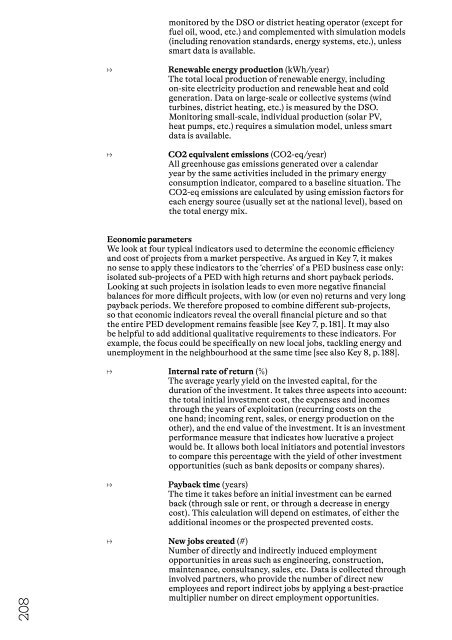Powering the energy transition at the district level_Cities4PEDs_AWB_final
Create successful ePaper yourself
Turn your PDF publications into a flip-book with our unique Google optimized e-Paper software.
monitored by <strong>the</strong> DSO or <strong>district</strong> he<strong>at</strong>ing oper<strong>at</strong>or (except for<br />
fuel oil, wood, etc.) and complemented with simul<strong>at</strong>ion models<br />
(including renov<strong>at</strong>ion standards, <strong>energy</strong> systems, etc.), unless<br />
smart d<strong>at</strong>a is available.<br />
↦<br />
↦<br />
Renewable <strong>energy</strong> production (kWh/year)<br />
The total local production of renewable <strong>energy</strong>, including<br />
on-site electricity production and renewable he<strong>at</strong> and cold<br />
gener<strong>at</strong>ion. D<strong>at</strong>a on large-scale or collective systems (wind<br />
turbines, <strong>district</strong> he<strong>at</strong>ing, etc.) is measured by <strong>the</strong> DSO.<br />
Monitoring small-scale, individual production (solar PV,<br />
he<strong>at</strong> pumps, etc.) requires a simul<strong>at</strong>ion model, unless smart<br />
d<strong>at</strong>a is available.<br />
CO2 equivalent emissions (CO2-eq/year)<br />
All greenhouse gas emissions gener<strong>at</strong>ed over a calendar<br />
year by <strong>the</strong> same activities included in <strong>the</strong> primary <strong>energy</strong><br />
consumption indic<strong>at</strong>or, compared to a baseline situ<strong>at</strong>ion. The<br />
CO2-eq emissions are calcul<strong>at</strong>ed by using emission factors for<br />
each <strong>energy</strong> source (usually set <strong>at</strong> <strong>the</strong> n<strong>at</strong>ional <strong>level</strong>), based on<br />
<strong>the</strong> total <strong>energy</strong> mix.<br />
Economic parameters<br />
We look <strong>at</strong> four typical indic<strong>at</strong>ors used to determine <strong>the</strong> economic efficiency<br />
and cost of projects from a market perspective. As argued in Key 7, it makes<br />
no sense to apply <strong>the</strong>se indic<strong>at</strong>ors to <strong>the</strong> ‘cherries’ of a PED business case only:<br />
isol<strong>at</strong>ed sub-projects of a PED with high returns and short payback periods.<br />
Looking <strong>at</strong> such projects in isol<strong>at</strong>ion leads to even more neg<strong>at</strong>ive financial<br />
balances for more difficult projects, with low (or even no) returns and very long<br />
payback periods. We <strong>the</strong>refore proposed to combine different sub-projects,<br />
so th<strong>at</strong> economic indic<strong>at</strong>ors reveal <strong>the</strong> overall financial picture and so th<strong>at</strong><br />
<strong>the</strong> entire PED development remains feasible [see Key 7, p. 181]. It may also<br />
be helpful to add additional qualit<strong>at</strong>ive requirements to <strong>the</strong>se indic<strong>at</strong>ors. For<br />
example, <strong>the</strong> focus could be specifically on new local jobs, tackling <strong>energy</strong> and<br />
unemployment in <strong>the</strong> neighbourhood <strong>at</strong> <strong>the</strong> same time [see also Key 8, p. 188].<br />
↦ Internal r<strong>at</strong>e of return (%)<br />
The average yearly yield on <strong>the</strong> invested capital, for <strong>the</strong><br />
dur<strong>at</strong>ion of <strong>the</strong> investment. It takes three aspects into account:<br />
<strong>the</strong> total initial investment cost, <strong>the</strong> expenses and incomes<br />
through <strong>the</strong> years of exploit<strong>at</strong>ion (recurring costs on <strong>the</strong><br />
one hand; incoming rent, sales, or <strong>energy</strong> production on <strong>the</strong><br />
o<strong>the</strong>r), and <strong>the</strong> end value of <strong>the</strong> investment. It is an investment<br />
performance measure th<strong>at</strong> indic<strong>at</strong>es how lucr<strong>at</strong>ive a project<br />
would be. It allows both local initi<strong>at</strong>ors and potential investors<br />
to compare this percentage with <strong>the</strong> yield of o<strong>the</strong>r investment<br />
opportunities (such as bank deposits or company shares).<br />
↦<br />
Payback time (years)<br />
The time it takes before an initial investment can be earned<br />
back (through sale or rent, or through a decrease in <strong>energy</strong><br />
cost). This calcul<strong>at</strong>ion will depend on estim<strong>at</strong>es, of ei<strong>the</strong>r <strong>the</strong><br />
additional incomes or <strong>the</strong> prospected prevented costs.<br />
208<br />
↦ New jobs cre<strong>at</strong>ed (#)<br />
Number of directly and indirectly induced employment<br />
opportunities in areas such as engineering, construction,<br />
maintenance, consultancy, sales, etc. D<strong>at</strong>a is collected through<br />
involved partners, who provide <strong>the</strong> number of direct new<br />
employees and report indirect jobs by applying a best-practice<br />
multiplier number on direct employment opportunities.

















